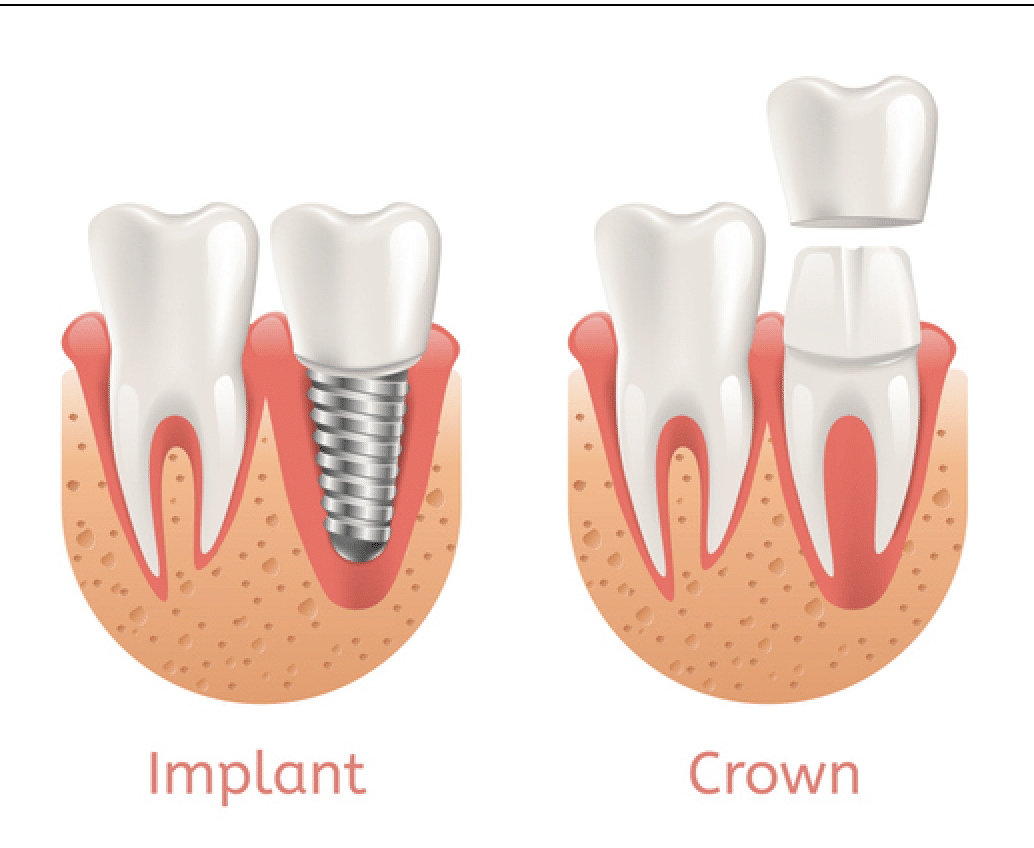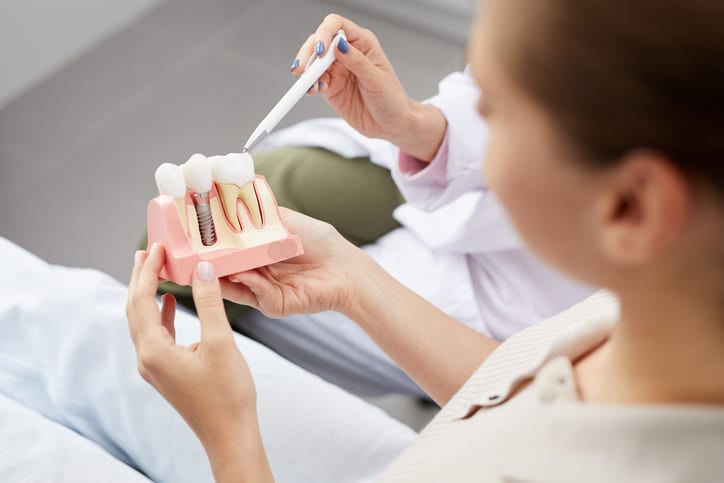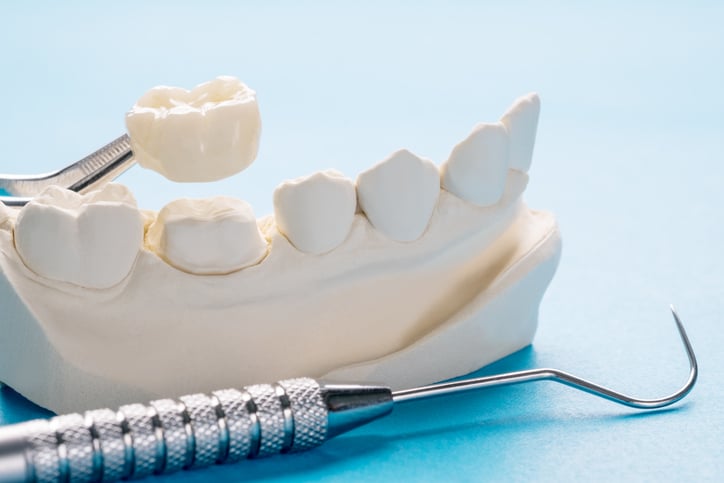Dental Implant vs Dental Crown: Pros and Cons from Rockford Dentist

Importance of dental health
Proper oral health care is as crucial as our health nowadays. Teeth are the main actors in our ability to speak, eat, and smile reassuringly. Nevertheless, accidents, rust, or diseases of the gums may result in circumstances where we are forced to replace or restore damaged teeth. In these situations, two main choices are dental implants and dental crowns. We will go over all the main differences between dental implant vs dental crown.
Common dental procedures
Tooth implants and crowns are two dental procedures that dentists often perform when restoring or replacing teeth. Both restorations favor function and aesthetics but use different approaches, techniques, and long-term complications.
Understanding Dental Implants
What are dental implants?
Dental implants are an advanced technology and reliable solution widely used today to replace missing teeth. They differ from normal dentures or bridges on top of the gums since implants are surgically inserted into the jawbone to serve similarly to a tooth’s natural root system.
The implant material used by the current implant is commonly titanium or other inert compounds widely accepted in the human body. Titanium is chosen as the primary material because it is the only material that can successfully osseointegrate, i.e., fuse with the live bone tissue. This fusion develops an amazingly strong and reliable base for the crown, which will be secured to the implant.
Procedure for getting dental implants
The procedure for getting dental implants is a multi-stage process that can take several months to complete: The procedure for getting dental implants is a multi-stage process that can take several months to complete:
- Initial Consultation and Evaluation: Your dentist or oral surgeon will perform a thorough examination, X-ray, and CT Scan to determine whether the bone is of good quality and density. Evaluation is, therefore, the major criterion for determining whether you have enough healthy bone to support the placement and whether additional treatments are required. The procedures normally necessitate bone grafting.
- Surgical Implant Placement: Going on to substep, the surgical incision will be made if you are accepted. The actual technique is done either using local anesthesia or IV sedation. The oral surgeon will do that with a calm incision on your gum, expose the jawbone in the opposite direction, and lightly fill a hole in the bone so the implant is placed. The implant will be placed in the desired location and left to heal. It will typically integrate with the surrounding bone tissue within the next several months.
- Osseointegration: This is the key phase in which implant-grade bone enters the bond, known as osseointegration. This is the phase in which the implant fuses with the jawbone and forms a stable and strong foundation. The timeframe of this process is 3 to 6 months, depending on the nature and quality of your bones and general health.
- Abutment Placement: After this implant has completely integrated with the bone, a minor surgical procedure will be performed to attach an abutment (a very small connecting piece) to the implant during this surgery. A cusp extrudes out of gum tissues through the gingival sulcus and serves as a retainer for the final tooth (crown).
- Crown Placement: Finally, a corresponding impression or a digital scan of your mouth is taken to make a custom-made crown, which is necessary to fit into the abutment already placed. We pay special attention to the features of your teeth to resemble the crown with exactly the shade, shape, and size of your natural teeth, making it unnoticeable. In this last stage of the procedure, the crown anchors anchors to the abutment, thus completing the implantation.
The dentist or oral surgeon will provide explicit guidance about post-operative care throughout the process. Therefore, it is crucial to follow the instructions properly and ensure a good outcome of the implant placement. This can include installing an appropriate diet, oral hygiene, and post-operation consultations to monitor the healing process.
Pros of Dental Implants
Know when it is best to get dental implants.

Natural look and feel
The other advantage of dental implants is that they are aesthetically pleasing to the touch. The implant-supported crown is made with material that complements the color of your surrounding teeth, making it almost impossible to point out that it is not a natural tooth. Moreover, teeth implants behave like natural teeth; you can eat, speak, and smile confidently without worrying about discomfort or restrictions.
Long-lasting solution
Dental implants preserved in good health can even be expected to last the rest of your life. Unlike new bridges or dentures that have to be replaced every 5-10 years, dental implants are placed to be permanent, as long as your oral hygiene is good and you visit your dentist regularly.
Preserve bone health
The absence of a tooth in the jawbone will erode it with time, as chewing actions no longer stimulate it. Dental implants are mainly intended to avoid this bone loss, as they integrate with the jawbone and promote it the same way as natural teeth, thus preventing further jawbone destruction.
Cons of dental implants
Costly procedure
Implants are generally more costly than other replacement methods, such as bridges or dentures. Charges vary based on the number used, procedure intricacy, and region. However, the long-term benefits and, most likely, lower replacement costs must also be considered.
Lengthy process
Getting dental implants is a multi-step procedure that involves several stages; thus, it takes several months to complete. The surgery at the beginning, the healing and osseointegration, and then abutment and crown placement for several months may take the entire period. If the period is prolonged, it would not suit some people who suddenly need an immediate solution.
Potential complications
Dental implants are widely successful; however, there is a chance of side effects and risks related to the procedure. Some complications may be infections, implant failure, nerve damage, or sinus (for upper jaw implants) problems. The best way to prevent these risks is to follow your dentist’s post-operative instructions and be on time for your follow-ups.
Understanding Dental Crowns

What are dental crowns?
Dental crowns are an all-purpose and highly efficient way of restoring bad, decayed, or poorly shaped teeth to their normal state. Such restorations are a type of cover that fits over only the visible part of a tooth, and hence, they offer both functional and aesthetic advantages to the teeth.
When a tooth is affected by the extent of decay, cracks, or root canals, the cosmetic appearance has to be changed by fixing a dental crown that will help restore its structure, strength, and appearance. Furthermore, crowns are widely used to cover implants or replace missing teeth via a dental bridge.
Procedure for getting dental crowns
The process of getting a dental crown typically involves the following steps: The process of getting a dental crown typically involves the following steps:
- Tooth Preparation: At the first visit, your dentist will bind the tooth shape to leave room for the crown. This requires removing just the right amount of enamel from the tooth surface to ensure the crown goes in comfortably and looks natural.
- Impressions or Digital Scans: If the tooth is ready for the process, your dentist proceeds and takes imprints or digital scans of your teeth, with the help of which the dentist gives you customized trays. Hence, these impressions or scans are sent to the dental lab, where individuals with specialized skills test the structure, size, and color of the teeth surrounding them.
- Temporary Crown: While the second crown is being made in the lab, your dentist will place a crown over the prepared tooth to protect it. My dentist put a temporary crown on my tooth to protect it, and I can use this tooth for chewing and speaking as I used to.
- Permanent Crown Placement: When your permanent crown is delivered in about a week, you can return to the dentist to adjust the fitting, but you’ll have to return to the dentist’s office. The placebo is then dismantled again, and the new permanent one is placed for the dentist to carefully check its function and aesthetics regarding fit, bite, and look. If everything checks out, the crown is bonded or cemented onto your prepared tooth.
Pros of dental crowns
Cost-effective solution
Compared with dental implants, dental crowns are a more budget-friendly option, which is an advantage for people with an income that doesn’t allow them to spend much. Hence, dental crowns are the more affordable option. The price may be higher than dental implants, but still lower. The cost depends on the kind of material used and the difficulty level of the procedures.
Relatively quick process
Even though the entire manufacturing process takes several weeks, applying a real dental crown is quite rapid, which may be shorter than getting a dental implant. When the tooth is ready and an impression is taken, it can generally be achieved within a few weeks, whereas the implant-supported crown is preferable for people concerned about the time frame.
Restore tooth function
Dental caps can be placed to replace a tooth lacking functionality or with problems such as decay or a crack. The crowns around the remaining tooth structure keep it from the possibility of further harm, thus allowing you to chew and bite like before, which helps you eat all the kinds of foods you want.
Cons of dental crowns
Shorter Lifespan
Even though dental crowns are composed of materials that are supposed to be resistant to aging, they usually last many years less than implants. The mean durability of a dental bridge is usually 5 to 15 years, which means that over 50% of patients need a redo after 5 to 10 years.
Several factors can contribute to the shorter lifespan of dental crowns:
- Wear and Tear: During a prolonged time, chewing and biting become the sources of friction against the crown, resulting in a decrease in its quality, which might end up in cracks, chips, and, finally, fractures.
- Bruxism (Teeth Grinding): Grind and clenching teeth habit can eventually lead to excess pressure on the crown, speeding up its wear and, therefore, leaving a risk of cracking or coming out of this crown.
- Oral Hygiene: Bad oral hygiene can lead to plaque and bacteria slipping around the crown, leading to decay or gum disease. The integrity of the crown and the teeth’s structure can also be weakened.
- Material Quality: Unlike poorer-quality materials, well-made crowns are designed to last. Likewise, all-metal crowns are stronger than porcelain ones, which are more likely to break.
For best results, you should observe good oral hygiene, avoid your teeth from being clamped or bitten, and visit dental checkups regularly; the dental health care provider can also resolve any problem you may encounter. Your dentist should recommend when it is time to replace your dental crown.
Potential for Tooth Sensitivity
Further disadvantages of dental crowns include tooth soreness or discomfort that may result after the procedure. Several factors can cause this sensitivity: Several factors can cause this sensitivity:
- Tooth Preparation: The tooth preparation step considerably limits the amount of enamel and leaves the dentin, known as dentin, visible. In this case, the collateral damage can be tooth sensitivity arising from heat, cold, or sweet stimuli, at least for the time being.
- Pressure from the Crown: Sometimes, the fit of a newly made crown is not entirely right, possibly damaging the underlying tooth or the gum tissue. This pressure may result in a feeling of discomfort or tooth sensitivity.
- Temporary Crown: The temporary crown may not be as snug as the permanent restoration to provide T on B. Food particles and bacteria may rub it off, exceeding the tooth and gum irritation, which results in sensitivity or discomfort.
Positively, the lid is going to be miniaturized. Consequently, care should be taken shortly while getting the treatment above. The dentist might ask you to use a desensitizing paste, avoid foods and beverages that can trigger your pain, or use painkillers to control discomfort.
When in place, sensitivity normally decreases to a minimum since the tooth and the gum tissue have had the time to get used to the new crown. Yet, suppose tenderness develops into more serious sensitivity. In that case, it is better to consult with someone with professional knowledge because an undiscovered problem behind that condition may be the reason why.

